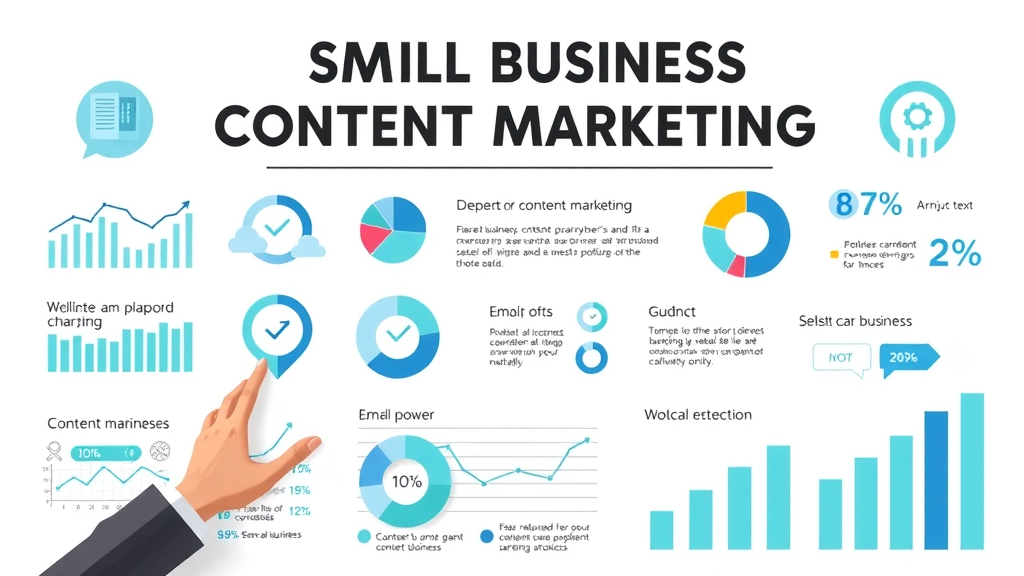Did you know that 70% of small businesses credit content marketing as their biggest driver of new leads—often seeing results in under 30 days? If you’re a small business owner eager to grow fast, this is your playbook. In a world where every dollar and minute counts, strategic content marketing can unlock rapid business growth, boost your brand presence, and build trust with your target audience—even on a limited budget. Read on for eye-opening facts, actionable steps, and proven small business content marketing tactics that work—fast.

Why Content Marketing Small Business Strategies Deliver Rapid Results
- An eye-opening 70% of small businesses say content marketing directly boosts leads. Discover why strategic content can fast-track results for small businesses, and learn industry facts that break common myths.
Content marketing small business strategies are uniquely positioned for speed and agility. Unlike larger corporations that require multiple approval layers, a nimble small business can identify pain points, create content, and publish relevant blog posts or videos in weeks—not months. This quick turnaround makes it easier to capitalize on trending topics, seasonal changes, or shifts in your target audience’s interests.
Not only does content marketing allow small businesses to create a direct and authentic connection with potential customers, but it also helps build trust by offering solutions to the real problems your community faces. By being active and responsive through quality content—like how-to posts, case studies, or social media campaigns—you quickly establish your business as a go-to resource, fostering loyalty and repeat business. Rapid implementation, genuine engagement, and instant feedback loops mean your business won’t be left behind in the digital race.
Content Marketing Small Business Essentials: Key Takeaways to Accelerate Your Success
- What you'll learn:
- Proven content marketing small business tactics
- How to develop a content strategy tailored to small businesses
- Ways to integrate social media for small business marketing
- Building an effective content marketing strategy on a budget
- The role of content calendar and content creation in business growth

Crafting a High-Impact Content Marketing Small Business Strategy
"Content marketing, when executed with a clear strategy, can deliver more sustainable growth for small businesses than any other digital tactic."
The Foundation of Content Marketing Strategy for Small Business
Every successful content marketing plan begins with understanding your business’s unique strengths and your audience’s biggest needs. Small businesses can achieve outsized results by tailoring their content strategy to address the most urgent pain points of their target audience. Start by mapping out the most relevant topics for your customers—what are their common questions? What problems can you solve better than anyone else?
From your first blog post to a regular email newsletter, each piece of content should be created with clear intent. Focus on delivering quality content that fits your customer’s journey—awareness, consideration, and decision. For example, an in-depth guide for first-time buyers or a tutorial about your service can make your brand stand out, even if your marketing budget is modest. Keep your focus on topics that build trust and showcase your expertise.
Research your competitors and audit existing content to spot gaps or underserved niches. Use these insights to guide your content creation, ensuring your small business is always a few steps ahead. When you create content based on real market analysis, you position your business as the expert, ready to attract and support both new and existing customers.
As you refine your content marketing approach, it's also valuable to consider how local search optimization can amplify your reach and attract more qualified leads. For actionable tips on boosting your visibility in your community, explore these local SEO strategies for small businesses that complement your content efforts.
Identifying Marketing Strategy Goals for Small Businesses
Defining SMART goals (Specific, Measurable, Achievable, Relevant, Time-bound) is crucial for any small business content marketing strategy . Are you aiming to increase website traffic by 30% in three months? Do you want to generate more leads or grow your email newsletter list? Get granular with your objectives, as clear goals keep your marketing efforts focused and measurable.
Often, small business owners overlook the value of creating content aimed at “micro-goals”—like encouraging social shares or capturing email addresses via lead magnets. Break large goals into smaller actions: for example, a single high-value blog post could serve as a landing page, drive sign-ups, and then be repurposed into social media content. Each goal should contribute directly to business growth and support your overall marketing plan.
Align goals with customer needs and business revenue drivers. For B2C retailers, this might mean frequent product updates or value stories; for B2B service providers, robust resources and in-depth tutorials foster trust and move potential customers along the funnel. Setting the right targets helps your small business stay agile, react quickly to opportunities, and maximize every piece of content you create.
Aligning Content Marketing With Overall Business Objectives
Treat your content marketing strategy as an extension of your greater business objectives. Every blog post, infographic, or podcast episode should seamlessly support your main business goals, whether it’s boosting sales, improving retention, or establishing your small business as an industry leader.
Start by mapping out which products or services you want to highlight each quarter. Build your content calendar around key launches, seasonal events, or customer milestones. For example, a landscaping business might publish spring garden prep tips ahead of busy season, while a bakery builds excitement for holiday specials with time-limited blog posts and social media content.
Remember: consistent messaging across all media channels—website, social platforms, and email newsletter—reinforces your position, improves recall, and reduces confusion for your target audience. By aligning every piece of content with your core business priorities, you multiply the impact of your limited resources, helping your message cut through the digital noise.
Content Creation for Small Business: Powerful Tactics That Work Fast
- List of high-performing content types for small businesses: blogs, video, infographics, podcasts.
When it comes to content creation for a small business, choosing the right format amplifies your reach and accelerates results. Blogs remain one of the most effective ways to drive traffic and address customer pain points—answering questions, highlighting success stories, and educating potential customers with depth. Well-crafted blog posts boost your search rankings and build trust over time.
Video and infographics are powerful tools for businesses looking to engage a visually-oriented target audience and explain complex topics quickly. Social media platforms like Instagram and TikTok favor short-form video, while Pinterest and LinkedIn users respond well to infographics and how-to guides. Podcasts give business owners a platform to share insights, interview industry experts, and build a loyal following—all while showcasing your authentic personality.
The trick is to test which formats resonate most with your audience and focus your efforts on creating quality content in those styles. Repurpose popular blog posts into short videos or transform podcast highlights into blog content for your website. Regularly refresh your content marketing plan, so your small business stays ahead of ever-changing media trends.

How to Use Content Calendar to Streamline Content Creation Processes
"A consistent content calendar can increase small business output by up to 30%."
A content calendar is your secret weapon for organizing and optimizing your entire content creation process. By planning ahead, you save time, avoid missed deadlines, and ensure that your small business maintains a steady stream of quality content—building trust and anticipation among your target audience.
Begin by mapping out major holidays, seasonal promotions, product launches, and key industry dates. Assign due dates for each piece of content, from blog posts to social media campaigns, and delegate responsibilities if you have a team. Digital tools like Trello, Asana, or even a simple Google Calendar make scheduling easy and flexible.
Keep your content calendar agile. Leave space for trending news or unexpected opportunities, and set regular intervals to review and update your schedule based on performance analytics. The result? More consistency, better campaign execution, and the ability to focus your creative energy where it counts most—growing your small business.

Repurposing Content Marketing Assets for Small Businesses
Repurposing is a game-changer for small businesses looking to squeeze maximum value from every piece of content. Instead of creating new material from scratch, turn one blog post into multiple social media content pieces, email newsletter highlights, or even video scripts. This approach not only saves time and money but also reinforces your messages across multiple media channels.
For example, a comprehensive how-to guide can become a series of quick tips on Instagram Stories, a podcast discussion, and a checklist for your website. Repurposing capitalizes on the strengths of each content format: some potential customers prefer to read, while others engage more with video or audio.
By recycling and reimagining existing content, you boost your brand presence, ensure consistent messaging, and make your content marketing strategy more resilient to changes in platform algorithms or consumer habits. This method allows even the smallest business owner to maintain a robust digital marketing presence without burning out.
Content Marketing Strategy Integration: Leveraging Social Media for Small Business Growth
| Platform | Best For | ROI Potential |
|---|---|---|
| Local Community Engagement | High | |
| Visual Brands/Products | Medium-High | |
| B2B Content Marketing | High | |
| TikTok | Viral, Short-form Content | Medium |
Social media is essential for content marketing small business success—and each platform offers unique strengths. Facebook excels at building engaged local communities; Instagram caters to visual storytelling, making it ideal for brands with eye-catching products; LinkedIn is perfect for B2B networking and educational content; while TikTok brings viral potential through short, creative videos.
Choosing the right channels for your business depends on where your target audience spends their time and the type of content you can consistently create. It’s easy for small businesses to spread themselves too thin—focus on one or two platforms initially, master those, then expand. Well-integrated social media efforts multiply the reach, amplify your core messages, and deliver measurable growth for your marketing strategy.

Content Marketing Tips for Choosing the Best Social Media Channels
Start by surveying your existing customers to learn where they spend time online. If your audience skews younger, TikTok or Instagram might hold more potential; if you’re focused on professionals, LinkedIn delivers better results. Next, consider what type of content you can consistently produce: beautiful photos, expert blog posts, or behind-the-scenes videos.
Track the performance of your initial social media campaigns, noting what gains the most engagement or drives the most website traffic. Use those insights to double down on the platforms (and content types) that work best. Don’t forget—quality trumps quantity. It’s better to excel on one channel with great social media content than to post mediocre pieces everywhere.
Lastly, make use of platform analytics. Both Facebook and Instagram offer useful dashboards that reveal your best-performing posts, peak engagement times, and demographic breakdowns, helping refine your ongoing content marketing strategy for maximum ROI.
Building a Social Media Content Calendar for Small Businesses
- Checklist: Steps to Create and Maintain a Social Media Calendar for Small Businesses
- Audit your current social media content and channels
- Define your posting frequency and content types (images, blog posts, videos, infographics)
- Schedule posts around promotional campaigns, product launches, and seasonal opportunities
- Allocate time for engagement (replies, shares, community building)
- Review analytics regularly and adjust your calendar for better results
A social media content calendar is not just about organization—it’s a strategic roadmap that allows small businesses to be proactive, not reactive. Stay consistent, anticipate industry trends, and see faster, more reliable growth from your content marketing efforts.
Optimizing Your Content Marketing Strategy: Data-Driven Decisions for Small Businesses
How to Use Analytics to Refine Small Business Content Strategy
"Small business owners who review content marketing analytics monthly see a 2X increase in conversion rates."
Regularly monitoring and interpreting analytics is what sets successful small businesses apart. Dive into tools like Google Analytics or Facebook Insights to track which blog posts, videos, or social media campaigns are driving the most traffic and conversions. Identify what resonates with your audience and what falls flat.
Set up clear KPIs (Key Performance Indicators) tied to your goals—for instance, website visitors, email signups, downloads, or direct sales. Review these metrics at least monthly to spot trends, uncover pain points, and optimize future content. Even minor tweaks (like changing blog post headlines or switching up Instagram visuals) based on data can lead to major improvements in results.
Remember, data-driven content marketing isn’t about chasing vanity metrics—it’s about focusing on what matters most to the business: leads, loyalty, and conversions. Use analytics as your guidepost, adjusting tactics and topics for maximum impact at every stage.

Budgeting Content Marketing for Small Business: Maximizing Impact with Limited Resources
Cost Breakdown: How Much Should Small Businesses Expect to Invest in Content Marketing?
| Category | Monthly Investment (USD) |
|---|---|
| Content Creation | $400 |
| Social Media | $200 |
| Automation Tools | $150 |
| Paid Promotion | $250 |
Content marketing doesn’t have to break the bank. As a small business, expect to allocate $1,000 or less per month to cover content creation , social media management, automation tools, and modest paid promotions. While some businesses spend more, many thrive by using free tools, strategic outsourcing, and leveraging existing assets—such as user-generated content, customer testimonials, or repurposed blog posts.
This investment should reflect your revenue and goals: early-stage startups may start lower, then scale up as results and resources allow. The key is consistent spending. Regular investment compounds over time, fueling organic growth and helping small businesses remain competitive—even against bigger brands with deeper pockets.
Affordable Content Marketing Tools for Small Businesses
- Top free and paid content marketing tools for small business owners
- Canva – Design infographics and visuals
- Buffer or Hootsuite – Schedule and manage social media posts
- Mailchimp – Create and automate email newsletters
- Google Analytics – Track content performance
- Grammarly – Edit and proof quality content
- Later – Instagram scheduling and visual planning
Most of these tools offer robust free versions—making them perfect for small businesses on a tight budget. Test several, find what fits your workflow, and don’t hesitate to upgrade as your content marketing strategy matures and grows.

Content Marketing Small Business Success Stories and Rapid Case Studies
- 1. A local retailer doubled website leads in 30 days using a strategic blog campaign.
- 2. A startup achieved viral growth via short-form video and content repurposing.
Real businesses, real results. Case studies like these showcase how well-executed content marketing small business tactics can deliver rapid, measurable improvements. For local retailers, indexing valuable blog posts around common customer questions led to a surge in organic traffic and qualified leads—no expensive advertising required.
A tech startup leveraged creative repurposing—turning customer testimonials into TikTok shorts, which quickly went viral and brought a flood of new signups. The lesson? When you focus on quality content, solve pain points, and adapt swiftly, even small businesses can achieve outsized wins in record time.

A complete walk-through on building a content marketing strategy tailored to small businesses—from audience research to publishing and measuring results.
Learn how to: Plan, organize, and maintain a practical content calendar designed specifically for small business needs—maximize consistency and save time!
Common Mistakes in Content Marketing Small Business Owners Must Avoid
- List of mistakes: Inconsistent posting, neglecting analytics, spreading too thin across channels, and underestimating content quality.
Even the best intentions can go astray. Small business owners often post sporadically or overlook analytics—missing crucial insights. Trying to be everywhere at once spreads resources thin, resulting in underwhelming media content and wasted effort. Prioritize quality content and regular analysis to sidestep these common pitfalls.
Compromising on content quality is another big mistake. Every piece of content represents your brand—make sure each blog post, social media update, or newsletter is clear, relevant, and valuable. With smart planning and a little discipline, small businesses can transform their content marketing results, avoiding these all-too-frequent missteps.
Actionable Checklist: Fast-Track Your Content Marketing Strategy for Small Businesses
- Step-by-step checklist:
- Define your audience
- Develop SMART objectives
- Create and populate a content calendar
- Measure performance and adapt quickly
Follow this checklist to go from “where do I start?” to a focused, agile marketing plan that delivers results for your small business—fast.
What is the 70 20 10 rule in content marketing?
The 70 20 10 rule in content marketing means 70% of your content should focus on what your audience cares about most (educational or entertaining), 20% should share content from others or niche-specific news, and 10% should directly promote your business. This rule keeps your content balanced, engaging, and relevant to your audience.
Understanding the 70 20 10 Rule in Content Marketing Small Business Plans
For small businesses, applying the 70 20 10 rule means investing the majority of your time addressing your customers’ core pain points and questions through blog posts, videos, or infographics. Share noteworthy industry news or tips from other sources 20% of the time, showcasing that you’re part of the broader conversation—not just self-promoting. Use the final 10% for focused promotions, calls to action, or exclusive offers that drive direct sales or inquiries.
This balance keeps your audience engaged, builds trust, and ensures you’re seen as more than just another advertiser—key traits for small business growth in any crowded market.
What are the 3 C's of content marketing?
The 3 C’s of content marketing are Create (develop unique and valuable content for your target audience), Curate (share relevant third-party resources or industry news), and Connect (engage authentically with your followers or community to build relationships).
Unpacking the 3 C's of Content Marketing for Small Businesses
Small businesses can succeed by consistently creating content tailored to their audience’s needs, curating valuable resources to keep their channels active, and connecting with potential customers by responding to comments, emails, and feedback. This three-part approach amplifies your reach, drives engagement, and builds a loyal supporter base.
Remember, connection isn’t just about pushing information—it’s listening, asking, and adjusting, so your content strategy always evolves with your audience.
What are the 4 P's of content marketing?
The 4 P’s of content marketing are Plan (set clear goals and strategies), Produce (create quality content), Publish (distribute content on appropriate platforms), and Promote (increase reach through sharing, ads, or partnerships).
Applying the 4 P's to Content Marketing Small Business Tactics
For small business owners, effective content marketing starts with proper planning—identify objectives, research your target audience, and set your tactics. Next, produce helpful blog posts, useful videos, and shareable infographics. Publish regularly to your website, social media, and email newsletter, then actively promote top-performing pieces through social sharing, collaborations, or paid campaigns. Each “P” keeps your strategy focused, actionable, and results-driven.
How much should a small business pay for marketing?
Most experts recommend small businesses allocate 7-8% of their gross revenue to their total marketing budget, including content marketing. For startups or competitive markets, that number may rise. The most effective approach is to start modestly, invest regularly, and increase spending as results become clear—prioritizing high-ROI tactics.
Budgeting Insights: Content Marketing Small Business Investment Benchmarks
Set a monthly marketing spend that matches both your current business scale and growth ambitions. Prioritize investments in tools, quality content creation, and targeted social media campaigns. Monitor ROI, and be ready to shift tactics where you see the best results.
Frequently Asked Questions About Content Marketing Small Business Tactics
- FAQ List:
-
What is the fastest way to see ROI from content marketing for small businesses?
Focus on high-impact formats such as blog posts or social media campaigns that solve urgent customer pain points, and use targeted distribution to amplify visibility quickly. -
How do I measure the performance of my small business content marketing strategy?
Track website traffic, leads generated, engagement rates, and conversions using analytics tools. Review data monthly to spot trends and identify what earns the best responses. -
Are there niche-specific content marketing tactics for small businesses?
Yes. Each niche has unique platforms, popular topics, and influencer opportunities. Research competitors, monitor hashtag trends, and experiment with new formats tailored to your business sector. -
How often should I update my content calendar?
Review and adjust your content calendar at least once a month, but be open to weekly tweaks based on analytics or emerging opportunities.
-
What is the fastest way to see ROI from content marketing for small businesses?
Summary of Action Steps for Rapid Content Marketing Small Business Success
- Key takeaways: Prioritize strategy, track data, optimize regularly, and remain agile to adapt to new small business challenges.
Ready to accelerate your small business growth? Put these content marketing small business tactics into action—define your strategy, create quality media content, and always measure, optimize, and adapt for best results.
If you’re looking to take your marketing to the next level, consider how a comprehensive approach can unify your content, branding, and digital outreach for even greater impact. Discover advanced frameworks and holistic planning methods in this guide to building a winning marketing strategy for small businesses . By integrating these broader strategies with your content marketing efforts, you’ll be better equipped to adapt, scale, and achieve sustainable growth. Explore new perspectives and unlock the next stage of your business’s marketing evolution.
 Add Row
Add Row  Add
Add 

Write A Comment